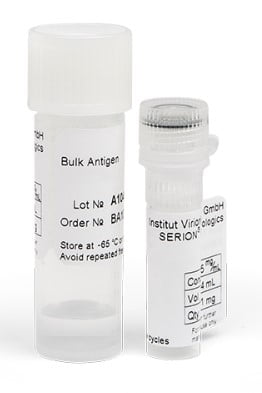| Weight | 1 lbs |
|---|---|
| Dimensions | 9 × 5 × 2 in |
| host | rabbit |
| isotype | IgG |
| clonality | polyclonal |
| concentration | 1 mg/mL |
| applications | ICC/IF, WB |
| reactivity | MMP 9 |
| available sizes | 100 µg |
rabbit anti-MMP9 polyclonal antibody 6573
$376.00
Antibody summary
- Rabbit polyclonal to MMP9
- Suitable for: WB
- Isotype: Whole IgG
- 100 µg
rabbit anti-MMP9 polyclonal antibody 6573
| antibody |
|---|
| Tested applications WB |
| Recommended dilutions Immunoblotting: use at 1:500-1:1,000 dilution. A band at 92 kD is detected. |
| Immunogen Synthetic peptide corresponding to aa 540-552 of human MMP 9. |
| Size and concentration 100µg and lot specific |
| Form liquid |
| Storage Instructions This antibody is stable for at least one (1) year at -20°C to -70°C. Store antibody in appropriate aliquots to avoid multiple freeze-thaw cycles. |
| Storage buffer PBS, pH 7.4. |
| Purity immunogen affinity purification |
| Clonality polyclonal |
| Isotype IgG |
| Compatible secondaries goat anti-rabbit IgG, H&L chain specific, peroxidase conjugated, conjugated polyclonal antibody 9512 goat anti-rabbit IgG, H&L chain specific, biotin conjugated polyclonal antibody 2079 goat anti-rabbit IgG, H&L chain specific, FITC conjugated polyclonal antibody 7863 goat anti-rabbit IgG, H&L chain specific, Cross Absorbed polyclonal antibody 2371 goat anti-rabbit IgG, H&L chain specific, biotin conjugated polyclonal antibody, crossabsorbed 1715 goat anti-rabbit IgG, H&L chain specific, FITC conjugated polyclonal antibody, crossabsorbed 1720 |
| Isotype control Rabbit polyclonal - Isotype Control |
| target relevance |
|---|
| Protein names Matrix metalloproteinase-9 (MMP-9) (EC 3.4.24.35) (92 kDa gelatinase) (92 kDa type IV collagenase) (Gelatinase B) (GELB) [Cleaved into: 67 kDa matrix metalloproteinase-9; 82 kDa matrix metalloproteinase-9] |
| Gene names MMP9,MMP9 CLG4B |
| Protein family Peptidase M10A family |
| Mass 78458Da |
| Function FUNCTION: Matrix metalloproteinase that plays an essential role in local proteolysis of the extracellular matrix and in leukocyte migration (PubMed:12879005, PubMed:1480034, PubMed:2551898). Could play a role in bone osteoclastic resorption (By similarity). Cleaves KiSS1 at a Gly-|-Leu bond (PubMed:12879005). Cleaves NINJ1 to generate the Secreted ninjurin-1 form (PubMed:32883094). Cleaves type IV and type V collagen into large C-terminal three quarter fragments and shorter N-terminal one quarter fragments (PubMed:1480034). Degrades fibronectin but not laminin or Pz-peptide. {ECO:0000250|UniProtKB:P41245, ECO:0000269|PubMed:12879005, ECO:0000269|PubMed:1480034, ECO:0000269|PubMed:2551898, ECO:0000269|PubMed:32883094}. |
| Catalytic activity CATALYTIC ACTIVITY: Reaction=Cleavage of gelatin types I and V and collagen types IV and V.; EC=3.4.24.35; Evidence={ECO:0000269|PubMed:1480034}; |
| Subellular location SUBCELLULAR LOCATION: Secreted, extracellular space, extracellular matrix {ECO:0000269|PubMed:2551898}. |
| Tissues TISSUE SPECIFICITY: Detected in neutrophils (at protein level) (PubMed:7683678). Produced by normal alveolar macrophages and granulocytes. {ECO:0000269|PubMed:7683678}. |
| Structure SUBUNIT: Exists as monomer or homodimer; disulfide-linked (PubMed:1281792, PubMed:7683678). Also exists as heterodimer with LCN2 (PubMed:1281792, PubMed:7683678). Macrophages and transformed cell lines produce only the monomeric form. Interacts with ECM1 (PubMed:16512877). {ECO:0000269|PubMed:10644727, ECO:0000269|PubMed:12051944, ECO:0000269|PubMed:12077439, ECO:0000269|PubMed:12126625, ECO:0000269|PubMed:1281792, ECO:0000269|PubMed:16512877, ECO:0000269|PubMed:7683678}.; SUBUNIT: (Microbial infection) Interacts with Staphylococcus aureus protein SSL5; this interaction inhibits MMP9 activity. {ECO:0000269|PubMed:20479083, ECO:0000269|PubMed:29328525}. |
| Post-translational modification PTM: Processing of the precursor yields different active forms of 64, 67 and 82 kDa. Sequentially processing by MMP3 yields the 82 kDa matrix metalloproteinase-9. {ECO:0000269|PubMed:1371271, ECO:0000269|PubMed:1400481}.; PTM: N- and O-glycosylated. {ECO:0000269|PubMed:1464361}. |
| Domain DOMAIN: The conserved cysteine present in the cysteine-switch motif binds the catalytic zinc ion, thus inhibiting the enzyme. The dissociation of the cysteine from the zinc ion upon the activation-peptide release activates the enzyme. {ECO:0000269|PubMed:12077439}. |
| Involvement in disease DISEASE: Intervertebral disc disease (IDD) [MIM:603932]: A common musculo-skeletal disorder caused by degeneration of intervertebral disks of the lumbar spine. It results in low-back pain and unilateral leg pain. {ECO:0000269|PubMed:18455130}. Note=Disease susceptibility is associated with variants affecting the gene represented in this entry.; DISEASE: Metaphyseal anadysplasia 2 (MANDP2) [MIM:613073]: A bone development disorder characterized by skeletal anomalies that resolve spontaneously with age. Clinical characteristics are evident from the first months of life and include slight shortness of stature and a mild varus deformity of the legs. Patients attain a normal stature in adolescence and show improvement or complete resolution of varus deformity of the legs and rhizomelic micromelia. {ECO:0000269|PubMed:19615667}. Note=The disease is caused by variants affecting the gene represented in this entry. |
| Target Relevance information above includes information from UniProt accession: P14780 |
| The UniProt Consortium |
Data
| No results found |
Publications
| pmid | title | authors | citation |
|---|---|---|---|
| We haven't added any publications to our database yet. | |||
Protocols
| relevant to this product |
|---|
| Western blot IHC ICC |
Documents
| # | SDS | Certificate | |
|---|---|---|---|
| Please enter your product and batch number here to retrieve product datasheet, SDS, and QC information. | |||
Only logged in customers who have purchased this product may leave a review.








Reviews
There are no reviews yet.